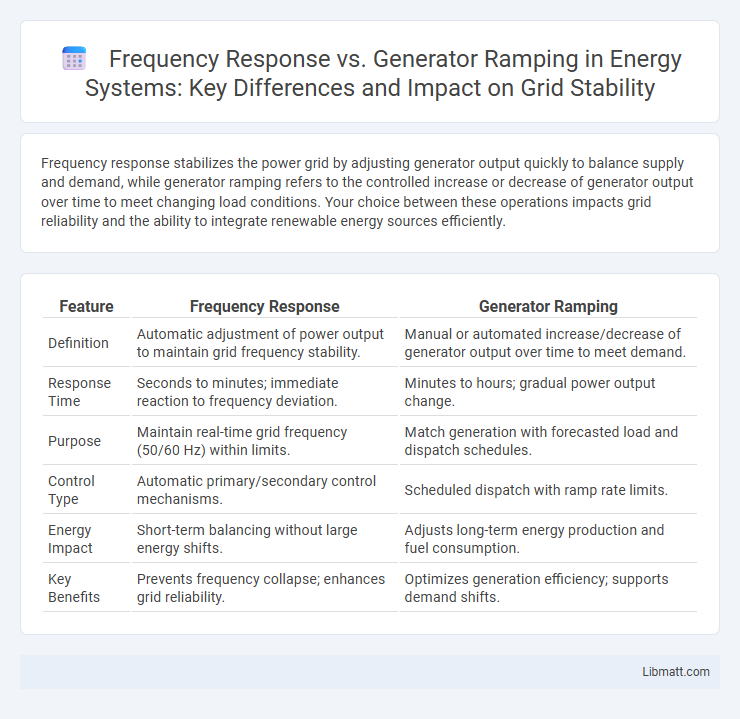Frequency response stabilizes the power grid by adjusting generator output quickly to balance supply and demand, while generator ramping refers to the controlled increase or decrease of generator output over time to meet changing load conditions. Your choice between these operations impacts grid reliability and the ability to integrate renewable energy sources efficiently.
Table of Comparison
| Feature | Frequency Response | Generator Ramping |
|---|---|---|
| Definition | Automatic adjustment of power output to maintain grid frequency stability. | Manual or automated increase/decrease of generator output over time to meet demand. |
| Response Time | Seconds to minutes; immediate reaction to frequency deviation. | Minutes to hours; gradual power output change. |
| Purpose | Maintain real-time grid frequency (50/60 Hz) within limits. | Match generation with forecasted load and dispatch schedules. |
| Control Type | Automatic primary/secondary control mechanisms. | Scheduled dispatch with ramp rate limits. |
| Energy Impact | Short-term balancing without large energy shifts. | Adjusts long-term energy production and fuel consumption. |
| Key Benefits | Prevents frequency collapse; enhances grid reliability. | Optimizes generation efficiency; supports demand shifts. |
Understanding Frequency Response in Power Systems
Frequency response in power systems refers to the automatic and immediate adjustment of generator output to balance supply and demand when system frequency deviates from its nominal value. Generator ramping rate, which defines how quickly a generator can increase or decrease its power output, directly impacts the effectiveness of frequency response in stabilizing the grid. Your ability to maintain system reliability depends on optimizing ramping capabilities to ensure rapid and accurate frequency corrections during fluctuations.
What is Generator Ramping?
Generator ramping refers to the rate at which a power generator can increase or decrease its output to match demand fluctuations. It plays a critical role in frequency response by enabling the grid to maintain stable frequency levels during sudden changes in load or generation. Your understanding of generator ramping helps optimize grid reliability and prevent frequency deviations that could disrupt power supply.
Key Differences: Frequency Response vs Generator Ramping
Frequency response refers to the grid's immediate reaction to frequency deviations by adjusting generator output within seconds to maintain stability, while generator ramping involves gradual adjustments in power output over minutes to hours based on forecasted demand changes. Frequency response acts as a rapid corrective mechanism to frequency imbalances, whereas ramping ensures smooth transitions between load levels and prevents sudden strain on generation assets. The key difference lies in the timescale and purpose: frequency response targets real-time frequency control, while ramping manages scheduled power output changes.
Importance of Frequency Response for Grid Stability
Frequency response is vital for maintaining grid stability by instantly counteracting imbalances between generation and load. Rapid generator ramping supports this by adjusting power output to correct frequency deviations within seconds to minutes. Effective coordination between frequency response and ramping capabilities ensures continuous grid reliability and prevents blackouts.
Role of Generator Ramping in Power System Operations
Generator ramping plays a critical role in maintaining system frequency stability by adjusting power output to match fluctuations in demand and supply. Fast and flexible ramping capabilities enable generators to respond promptly to frequency deviations, reducing the risk of frequency excursions and grid instability. Effective ramping supports integration of variable renewable energy sources, enhancing overall reliability and frequency response performance in power system operations.
How Frequency Response Supports Renewable Integration
Frequency response stabilizes grid frequency by rapidly adjusting generator output in reaction to supply fluctuations caused by variable renewable energy sources like wind and solar. Enhanced frequency response capabilities, including fast-ramping generators and energy storage systems, mitigate the intermittency challenges of renewables, maintaining grid reliability. This dynamic support is crucial for integrating high shares of renewable energy while preventing frequency deviations that could lead to outages.
Challenges of Achieving Effective Generator Ramping
Effective generator ramping is challenged by the need to balance frequency response demands with operational constraints of power plants, including mechanical inertia and thermal limits. Rapid ramping can lead to increased wear and tear on equipment, reducing generator lifespan and reliability. Grid operators must optimize ramp rates to maintain system frequency stability while minimizing the risk of load imbalances and generator stress.
Impacts on Grid Reliability and Performance
Frequency response and generator ramping critically influence grid reliability and performance by stabilizing system frequency during demand fluctuations and generation variability. Effective frequency response mitigates frequency deviations, preventing grid instability and equipment damage, while rapid and precise generator ramping ensures supply-demand balance, minimizing frequency nadirs and peaks. Together, optimized frequency response and generator ramping reduce system stress, enhance resilience against disturbances, and support integration of renewable energy sources for a stable and efficient power grid.
Control Strategies for Frequency Response and Ramp Rates
Effective control strategies for frequency response prioritize rapid generator ramping capabilities to maintain grid stability during sudden load changes or generation fluctuations. Advanced algorithms integrate real-time frequency measurements with automated generator ramp rate adjustments, ensuring an optimal balance between response speed and system reliability. Enhanced ramp rate flexibility in generators supports more precise frequency regulation, reducing the risk of blackouts and improving overall grid resilience.
Future Trends: Enhancing Grid Flexibility with Advanced Controls
Future trends in frequency response emphasize integrating advanced generator ramping controls to enhance grid flexibility, allowing faster and more precise adjustments to power output in response to frequency deviations. The deployment of intelligent control systems and real-time data analytics optimizes ramp rates, supporting higher renewable energy penetration and maintaining system stability. Enhanced coordination between frequency response mechanisms and generator ramping capabilities is critical for managing variability and ensuring reliable grid operation in evolving energy markets.
Frequency response vs Generator ramping Infographic

 libmatt.com
libmatt.com